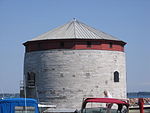Battle of Fort Frontenac

The Battle of Fort Frontenac took place on August 26–28, 1758 during the Seven Years' War (referred to as the French and Indian War in the United States) between France and Great Britain. The location of the battle was Fort Frontenac, a French fort and trading post which is located at the site of present-day Kingston, Ontario, at the eastern end of Lake Ontario where it drains into the St. Lawrence River. British Lieutenant Colonel John Bradstreet led an army of over 3,000 men, of whom about 150 were regulars and the remainder were provincial militia. The army besieged the 110 people inside the fort and won their surrender two days later, cutting one of the two major communication and supply lines between the major eastern centres of Montreal and Quebec City and France's western territories (the northern route, along the Ottawa River, remained open throughout the war). The British captured goods worth 800,000 livres from the trading post.
Excerpt from the Wikipedia article Battle of Fort Frontenac (License: CC BY-SA 3.0, Authors, Images).Battle of Fort Frontenac
Ontario Street, Kingston
Geographical coordinates (GPS) Address Nearby Places Show on map
Geographical coordinates (GPS)
| Latitude | Longitude |
|---|---|
| N 44.233333333333 ° | E -76.478611111111 ° |
Address
Canadian Army Command and Staff College
Ontario Street 317
K7K 0B4 Kingston
Ontario, Canada
Open on Google Maps






